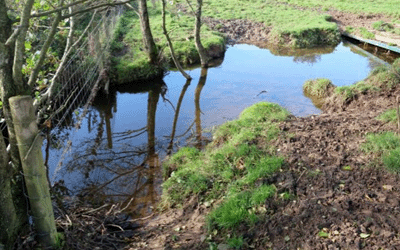Healthy wild Atlantic salmon populations need clean, unpolluted water to survive. There are a number of water quality issues relating to a range of pressures, including acidification, point-source and diffuse pollution and eutrophication.
Point-source pollution
Point source discharges include any release of effluent or other matter to the water environment or land, via a pipe or outlet and includes sewage and trade effluent, surface water discharges from urban areas, and abandoned mine discharges. The Scottish Environment Protection Agency (SEPA) regulates all such discharges through the Controlled Activity Regulations (CAR).
Fisheries Management Scotland support our members in highlighting the above issues to SEPA. We are also pressing SEPA to place an increased focus on a stronger regulatory approach, including enforcement penalties.
If you are aware of any of these issues, please contact SEPA directly via their website and call centre.
Diffuse pollution
Diffuse pollution is the release of potential pollutants from a range of activities that individually may have no effect on the water environment, but at the scale of a catchment can have a significant impact.  It arises from land use and management, and includes livestock grazing, cultivation of land, run-off from urban areas and forestry activities. These activities are regulated by SEPA through the Controlled Activity Regulations (CAR).
It arises from land use and management, and includes livestock grazing, cultivation of land, run-off from urban areas and forestry activities. These activities are regulated by SEPA through the Controlled Activity Regulations (CAR).
Diffuse pollution can cause siltation of Atlantic salmon spawning grounds and wider impacts on water quality and biodiversity. Use of arable pesticides include herbicides, fungicides and insecticides can also have negative impacts on the wider environment, affecting non-target organisms and aquatic ecosystems.
Members of Fisheries Management Scotland work closely with SEPA to identify breaches of the general binding rules relating to diffuse pollution. SEPA’s approach to date has focussed on engagement and farm visits to encourage famers and other landowners to meet general binding rules. However, we are also seeking assurance that meeting the current general binding rules is sufficient to result in real improvements in environmental conditions.
Whilst preventing diffuse pollution is an important aspect of improving water quality, we are also of the view that restoring habitat is equally important. Fisheries Management Scotland members have placed a strong emphasis on riparian habitat improvements, through stock fencing etc. and we would therefore like to see a greater emphasis on well-designed green engineering, riparian tree planting and peatland restoration in SEPA’s overall strategy.
Eutrophication
Eutrophication is an excess of nutrients in a water body, frequently due to run-off from land, which causes a dense growth of plant life. Eutrophication can arise from a number of sources including, fertiliser run-off into nearby water. Excess nutrients lead to phytoplankton grown which can disrupt normal ecosystem functioning and increase the biological oxygen demand in the water.
Acidification
Atlantic salmon can be severely affected by acidification in their freshwater phase. Sensitivity to acidic water increases during smolting and can affect the tolerance of the fish to seawater. Increases in soil and surface water acidity are driven by the deposition of pollutants and can be exacerbated by the underlying geology (which can limit the capacity to neutralise acidic inputs), degradation of peatland and conifer afforestation.
Acidification is a particular issue in the rivers of south-west Scotland, and we work with the Galloway Fisheries Trust in particular to highlight these issues. Acidification is often exacerbated by afforestation and peatland degradation and in some rivers is the main limiting factor for juvenile Atlantic salmon recruitment. Galloway Fisheries Trusts have identified a range of improvements which could be made, improvements could be made including deciduous tree planting, removal of Sitka spruce regeneration, woody debris addition, gravel addition and boulder placement. Habitat availability could also be improved by opening up small watercourses which have previously been diverted or altered by forestry plantations, which would also improve water quality as alterations are made.
